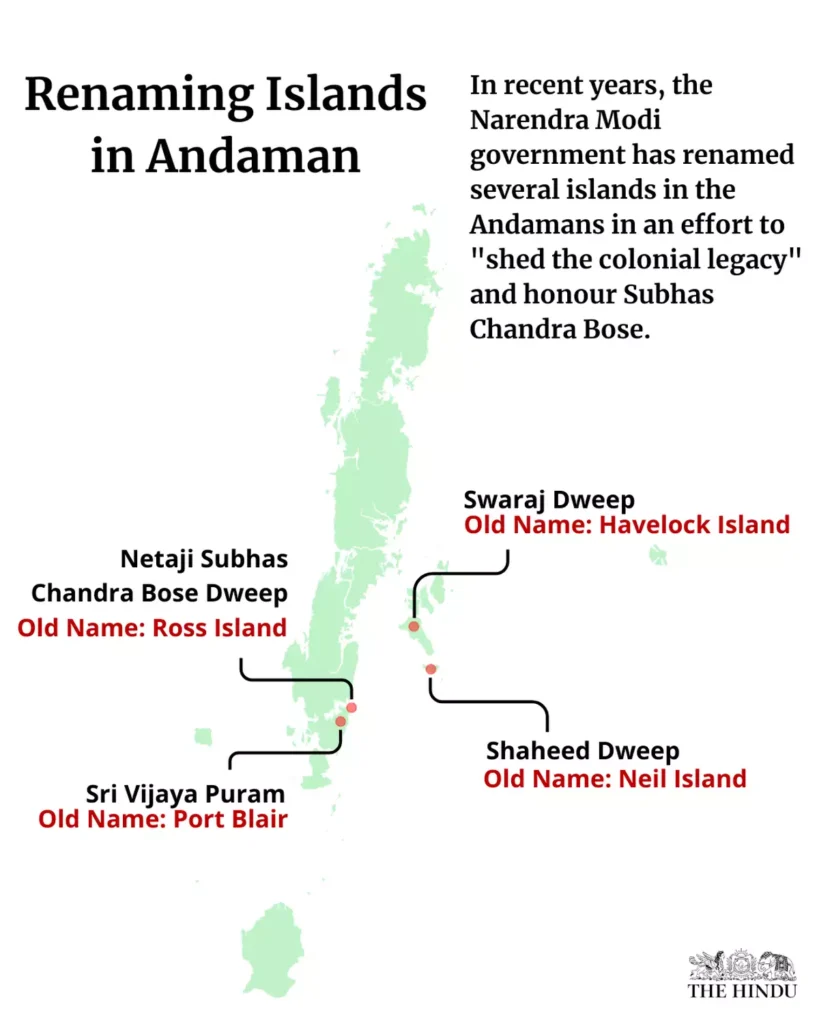The capital of the Andaman and Nicobar Islands, Port Blair, has recently been renamed as ‘Sri Vijaya Puram,’ as part of the initiative to remove colonial imprints, aligning with the vision of India’s leadership.
- The renaming symbolizes the contribution of the Andaman & Nicobar Islands to India’s freedom struggle and the historical connection with the Chola Empire and its naval power.
Background and Renaming:
- Port Blair was named after a British naval officer who surveyed the Andaman Islands in the 18th century.
- The new name Sri Vijaya Puram reflects the region’s historical ties with the Chola Empire and its naval expeditions against Srivijaya (present-day Indonesia).
- The decision is part of a broader effort to recognize the indigenous and historical identity of regions across India, moving away from colonial names.
Historical Context of Port Blair:
- Port Blair’s Origin:
- Named after a British naval officer who explored the Andaman Islands.
- Initially called Port Cornwallis, later renamed Port Blair after its surveyor.
- The islands were used by the East India Company as a penal colony, particularly after the Revolt of 1857, and housed prominent freedom fighters in the Cellular Jail.
- Connection with the Chola Empire:
- The Chola Empire, particularly under Rajendra I (1014-1044), is believed to have used the Andaman Islands as a naval base for expeditions to Southeast Asia.
- The Chola navy played a pivotal role in the conquest of the Srivijaya Empire in Indonesia during the 11th century.
- Inscriptional evidence from Thanjavur suggests that the Cholas referred to the Andaman Islands as Ma-Nakkavaram (great open land), which eventually became modern Nicobar.
Significance of Sri Vijaya Puram
- Symbol of Victory:
- The new name highlights the victory of Indian forces during the freedom struggle and the historical legacy of the region.
- The Cellular Jail and the first hoisting of the Indian flag by Netaji Subhas Chandra Bose during the independence movement mark the island’s unique contribution.
- Strategic Importance:
- During the Chola Empire, the Andaman Islands served as a naval base for military expeditions.
- The Chola naval power was instrumental in asserting dominance over the Bay of Bengal, transforming it into what was called the ‘Chola Lake’.
- Contribution to India’s Freedom Movement:
- Sri Vijaya Puram is historically significant as the place where Netaji Subhas Chandra Bose first unfurled the Tiranga (Indian flag).
- The infamous Cellular Jail, a major site where freedom fighters were imprisoned, is located here, underlining the Andaman & Nicobar Islands’ role in India’s fight for independence.
- Departure from Colonial Legacy:
- The renaming is part of the initiative to remove colonial imprints and restore the indigenous and historical identity of regions across India.
- Sri Vijaya Puram reflects the island’s connection with the Chola Empire, which had established its naval base here.
The Naval Power of the Chola Empire
Development of a Strong Navy:
- Chola rulers like Rajaraja I (985-1014) and Rajendra I (1014-1044) expanded the empire through aggressive military campaigns and naval dominance.
- The Cholas’ strategic location along the coast facilitated trade with Southeast Asia and ensured maritime control over the region.
Strategic Role of the Bay of Bengal:
- Under the Cholas, the Bay of Bengal was transformed into what was referred to as the ‘Chola Lake’ due to their control over maritime trade routes.
- This dominance enabled flourishing trade relations with Southeast Asia, part of their early Look East Policy, which saw the establishment of key trading centers like Nagapattinam.
Significant Naval Expeditions:
- Rajaraja I:
- Destroyed the Chera navy at Kandalursalai.
- Conquered Sri Lanka, annexing its northern part, and also led campaigns against the Maldives.
- Rajendra I:
- His naval conquests included the complete subjugation of Sri Lanka, making it a Chola province.
- Launched a major naval expedition against the Srivijaya Empire, conquering parts of the Malay Peninsula and Sumatra.
- The naval expeditions helped the Cholas expand their influence across Southeast Asia, enhancing trade relations and establishing important ports like Nagapattinam.
Conclusion
- The renaming of Port Blair to Sri Vijaya Puram underscores the importance of recognizing indigenous and historical identities while shedding colonial legacies.
- The Chola Empire’s naval power and their influence in Southeast Asia, particularly their expedition against Srivijaya, remain a significant part of India’s maritime and historical legacy, now symbolically revived in the new name of the Andaman Islands’ capital.
Ref: Source
| UPSC IAS Preparation Resources | |
| Current Affairs Analysis | Topperspedia |
| GS Shots | Simply Explained |
| Daily Flash Cards | Daily Quiz |
Frequently Asked Question:
Why was Port Blair renamed Sri Vijaya Puram?
Port Blair was renamed to honor the region’s historical ties with the Chola Empire and its role in India’s freedom struggle.
What is the significance of the new name Sri Vijaya Puram?
It reflects the Chola Empire’s naval power and the Andaman Islands’ contribution to India’s freedom struggle.
What was Port Blair’s original name?
Port Blair was originally named Port Cornwallis before it was renamed after a British naval officer.
How are the Andaman Islands connected to the Chola Empire?
The Chola Empire used the Andaman Islands as a naval base for their Southeast Asian expeditions during the 11th century.
What is the historical importance of the Cellular Jail in Port Blair?
The Cellular Jail housed freedom fighters during the British rule, marking the Andaman Islands’ significant role in India’s independence movement.




